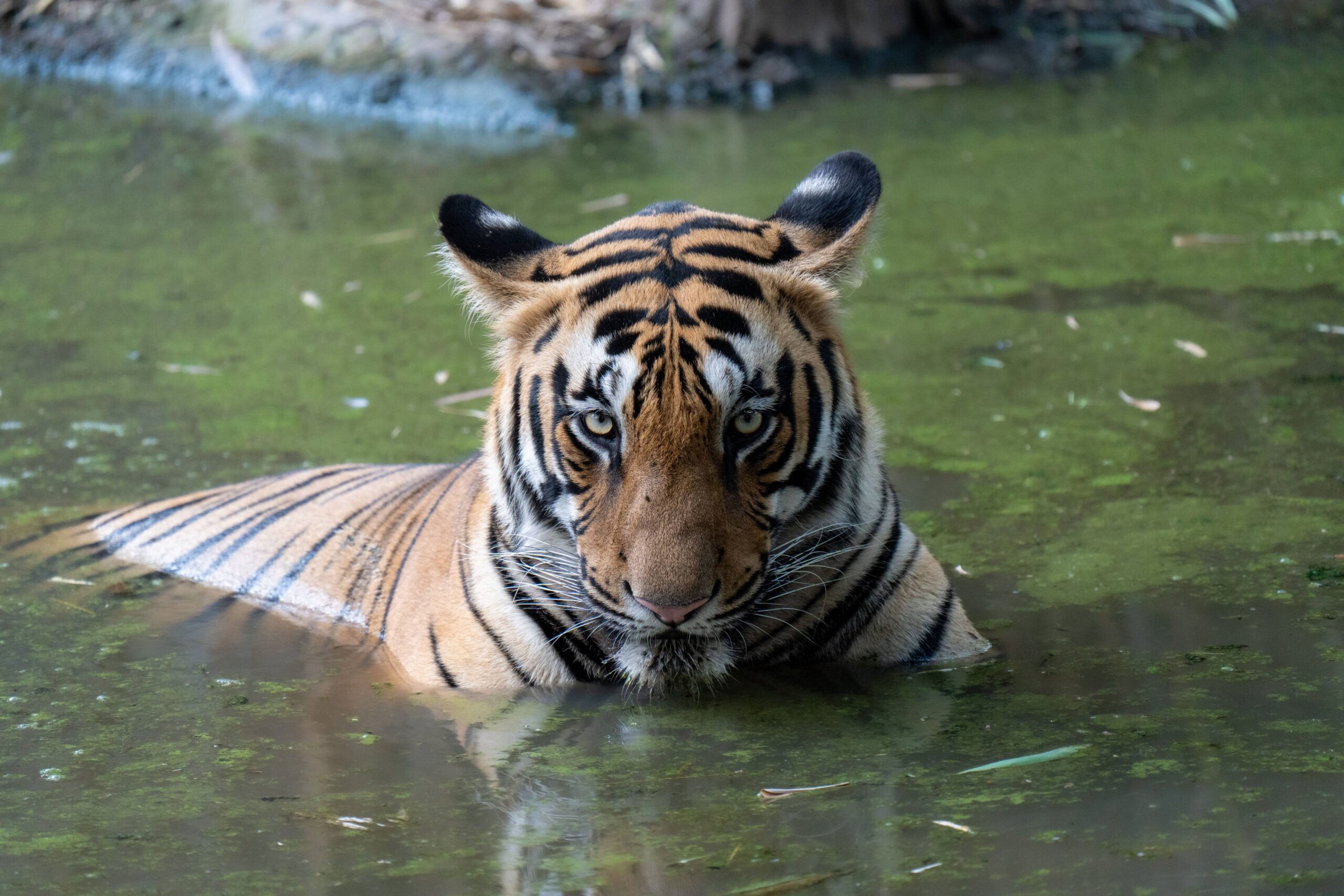India has a great diversity of wildlife and holds a reputation for owning the highest number of wild cat species in its forest landscapes. Out of the forty species existing in the Felidae family, fifteen are found in the Indian subcontinent.
These are further classified into three different categories based on their size as – Big cats of India, Medium-sized cats of India, and Small cats of India.
Let us introduce you to these 15 wild cat species and share some interesting attributes about their elusive lives.
Wild CATS Of INDIA

1. Royal Bengal Tiger (Panthera Tigris)
IUCN status- Endangered
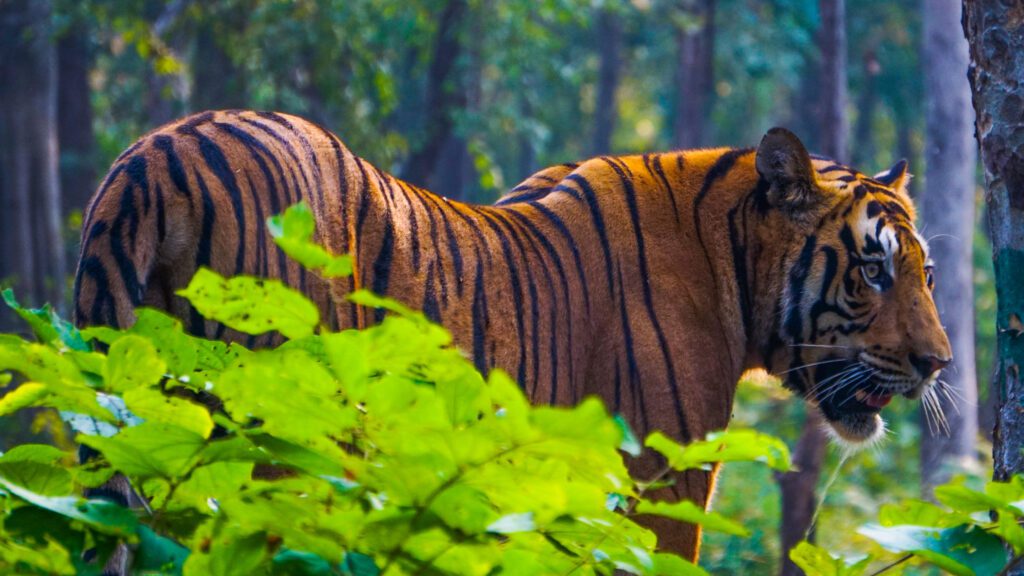
Undoubtedly the largest wild cat species alive on earth, the Royal Bengal tiger is the national animal of India. The distinguished population exists in India, while a few healthy populations also do thrive in small pockets in countries like Nepal, Bhutan, and Bangladesh.
Tigers are considered as one of the most charismatic cats in the wild. After a drastic decline during the last decade, the tiger population has recently stabilized in India. With nearly 3000 tigers, India has a stronghold in terms of an abode for this regal feline.
It is heartening to know, that despite being one of the most densely populated countries in the world, India has not only managed to save tigers but also successfully raised their numbers. Being a flagship species, it has benefitted the conservation of other wildlife species and the protection of large forested areas.
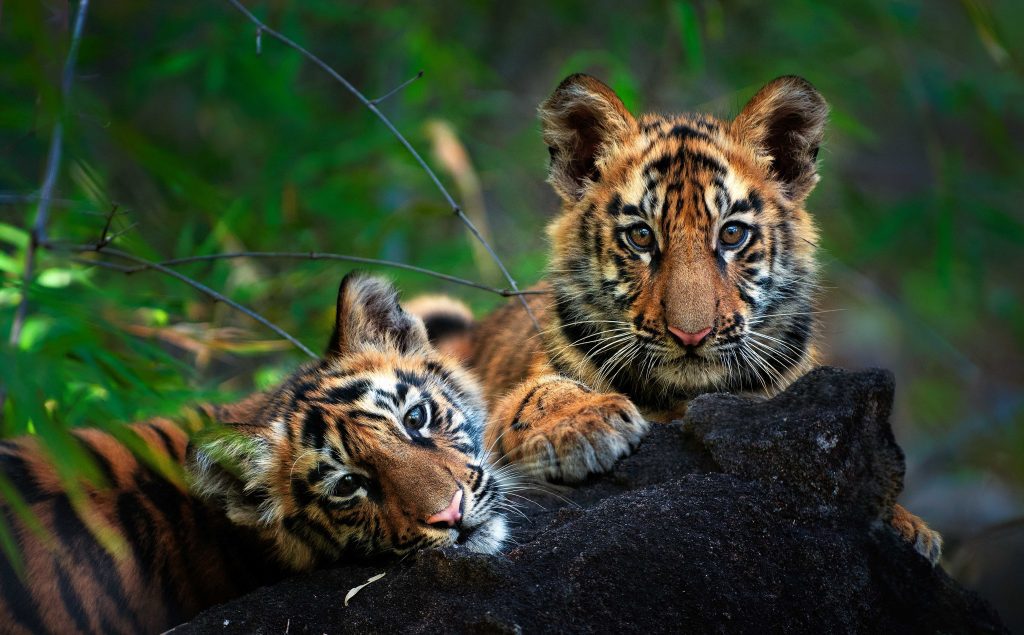
Tigers are territorial cats and spend most of their time resting in caves, grasslands, mangroves, waterholes, and bamboo thickets. They prefer to hunt spotted deer, sambar deer, wild pigs, etc., and at times domestic cattle. Their gestation period is around 105 days and on average 2-4 cubs are born. After about 18 months to 2 years, the cubs separate from the mother and other siblings and look out for their territories. A fully grown male tiger can easily weigh up to 250 kg.
Best places for tiger safari in India – Bandhavgarh, Kanha, Tadoba, Pench, and Ranthambore National Park.
2. Asiatic Lion (Panthera Leo)
IUCN status- Endangered
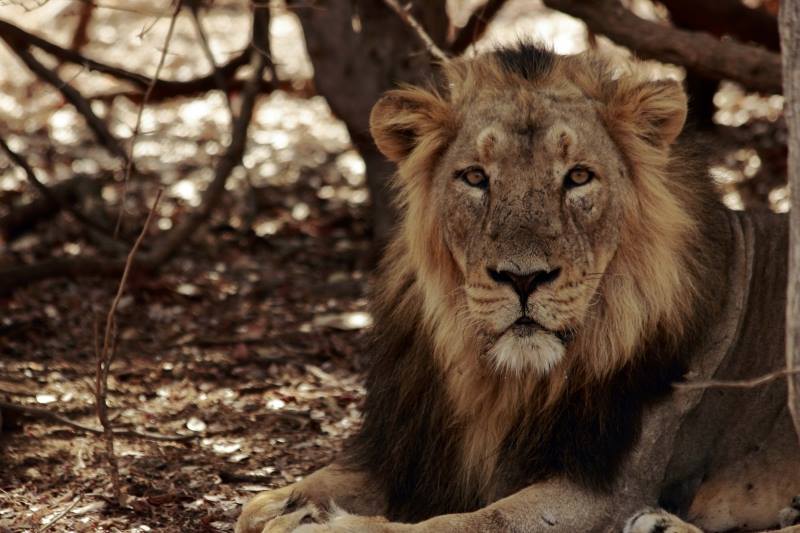
Formerly Asiatic lions dwelt in the lands of the Middle East to Bengal in India. But today they are restricted only to Gir national park in Gujarat, with the current population pegged around 670. One of the noticeable characteristics of Asiatic Lions is their longitudinal fold of skin which runs along their belly. This skin fold is absent in the African Lions. Even the Asiatic males are less social and do not stay with the females unless it is a mating season or sharing their kill.
Their primary diet comprises wild ungulates like deer, sambar, and wild pigs. Livestock too contributes to their favored meal. The main threat they face today is genetic inbreeding arising from a single population.
There is a lot of debate among researchers in India about their origin. A few feel that lions are not indigenous to India, an interesting read on the same is ‘Exotic Aliens’ by Valmik Thapar. But this theory is fiercely contested by many others.
Best place to see lions in India – Gir national park in Gujarat.
3. Indian Leopard (Panthera pardus)
IUCN status- Near Threatened

Leopards are renowned for their unique skill set of agility and adaptation, making it one of the most successful wild cats in the world. It is found across the country, and even in densely populated cities like Mumbai, Gurugram, Bangalore, Mysore, etc. where they primarily survive on stray dogs and pigs.
This stealthy and elusive creature is an excellent climber. They have black rosettes (rose-like marking found on the fur and skin) marked on their body. This pattern of rosettes is unique to each individual and hence helps in their identification.
Leopards are opportunistic hunters built for strength, rather than speed as they are more likely to drag their kill up the tree. Their primary diet comprises deer, wild pigs, monkeys, and even domestic livestock. They prefer to keep a very low profile in tiger-dominated parks, yet successfully manage to raise cubs and hold their territories.
In the last few years, there have been many records of a black panther or melanistic leopard sightings in India, which is basically its colour variant. They have been frequently sighted in parks like Nagarhole, Dandeli, and Tadoba.
Best places to see leopards in India – Satpura, Nagarhole, Pench, Tadoba, Jhalana, Bera, Panna, and Bandipur National Parks
4. Snow Leopard (Panthera uncia)
IUCN status- Endangered

As the name suggests, Snow leopards are found in the high altitudes of mighty Himalayas. In holds three records:
- A predator found at the highest altitude
- Long-tail as compared to its body size
- Only big cat which cannot roar due to its rigid hyoid bone
The sturdy built of Snow Leopard allows it to scale great steep slopes proficiently. Males weigh 45-55 kg whereas females weigh around 35-40 kg.
The primary food of this big cat is the blue sheep and mountain Ibex. It also preys on domestic goats, marmots, pikas, and hares. Their lifespan is around 15-18 years in the wild.
As it is the only top predator of high altitude habitat, it is also an ecological indicator of its health. If it thrives, so will other species in that region.
Snow leopard research has gained momentum in the last few years and they have now been recorded in a large area above 4000 meters including Nepal, Bhutan, China, and Mongolia. Recent research indicates that a male snow leopard has a range of around 80 sq. km. and a female around 45-50 sq. km.
Best places to see snow leopards in India – are Hemis national park, Ulley in Ladakh and Spiti Valley in Himachal Pradesh
5. Indo-Chinese Clouded Leopard (Neofelis nebulosa)
IUCN status-Vulnerable

The smallest big cat of India, the Indo-Chinese Clouded leopard is secretive and known to keep a low profile in the wild. They are solitary cats and weigh up to 11-23 kg. They have grey cloud-shaped marks on their coats, striped cheeks, and spots on its tail. They possess the longest canine teeth, relative to their skull as compared to any other cat species in the world.
These cats are arboreal and can easily hang upside down from their hind legs. Their large paws and sharp claws help to secure a good grip on the tree, thus helping them to ambush and prey on monkeys. They even raise their cubs on tree hollows.
Best place to see Clouded Leopard in India – Himalayan foothills of North-East India, Namdapha National Park, Arunachal Pradesh, and Greater Manas in Assam. Sightings are rare and most records are obtained using camera traps.
MEDIUM-SIZED CATS Of INDIA

1. Jungle Cat (Felis chaus)
IUCN status- Least Concern
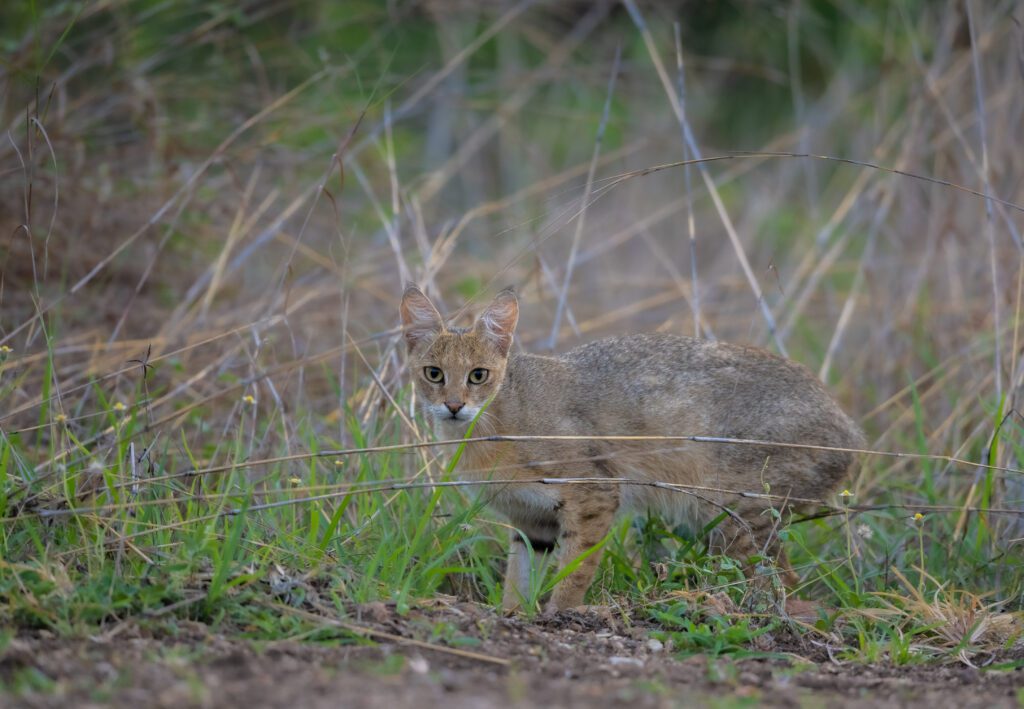
One of the most widespread and common wild cats in India is the Jungle cat. Regardless of the name, they are generally seen around dense vegetative cover, wetlands, shrubs, the fringe of the villages, and forest. They are nocturnal but not very strictly, and they like to rest in burrows of porcupines, badgers, and even foxes.
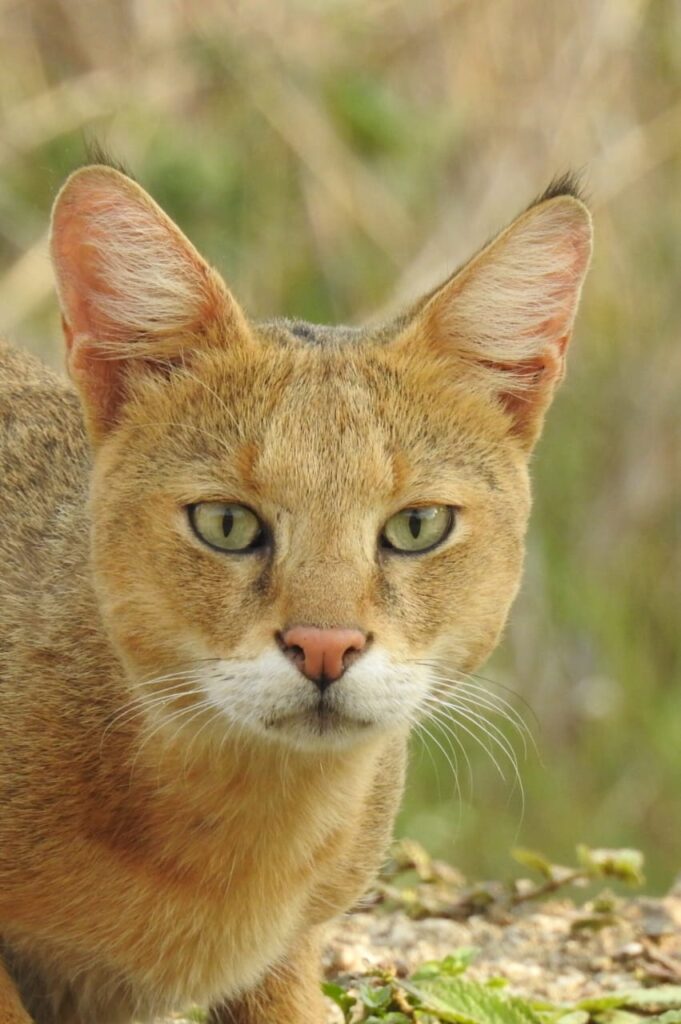
They are solitary, except during mating or while raising kittens. Their gestation period is brief, lasting for two months. Normally 2 to 6 kittens are born in a litter. The young ones separate after 8 to 10 months and mature in a year itself. They have equal-sized claws on both fore and hind legs. Being efficient hunters, they have a variety of prey base including rodents, birds, snakes, lizards and frogs.

Best place to spot Jungle Cat in India – Satpura, Panna, Khijadiya Bird Sanctuary, Ranthambore, Bandhavgarh and Pench. It is also sighted in scrublands and rural areas while driving late in the evening.
2. Fishing Cat (Prionailurus viverrinus)
IUCN status- Vulnerable

Fishing cat, the state animal of West Bengal, is also found in mangrove forests of the Sundarbans, on the foothills of the Himalayas in the Terai region, along the Ganga and Brahmaputra river valleys and in the Western Ghats.
As the name suggests, they primarily hunt for fish. They are known to prey on frogs, crustaceans, snakes, birds, too. Being residents of wetland habitats, they are good swimmers and nocturnal by nature. The layered structure of their fur provides thermal insulation and acts as a barrier to water.
These small cats are very aggressive. Their coat is olive-grey, and their cheek possesses two dark stripes on both sides. They inhabit wetlands, tidal creeks, marshy lands, and mangrove forests. They weigh from 5 to 16 kg. Similar to several other smaller feline members, it communicates through hisses, gruff growls, and very rarely a low, demanding meow.
Best place to spot the Fishing cat in India – Sundarbans, Bharatpur and Western Ghats
3. Pallas’s cat (Octolobus manul)
IUCN status- Least Concern
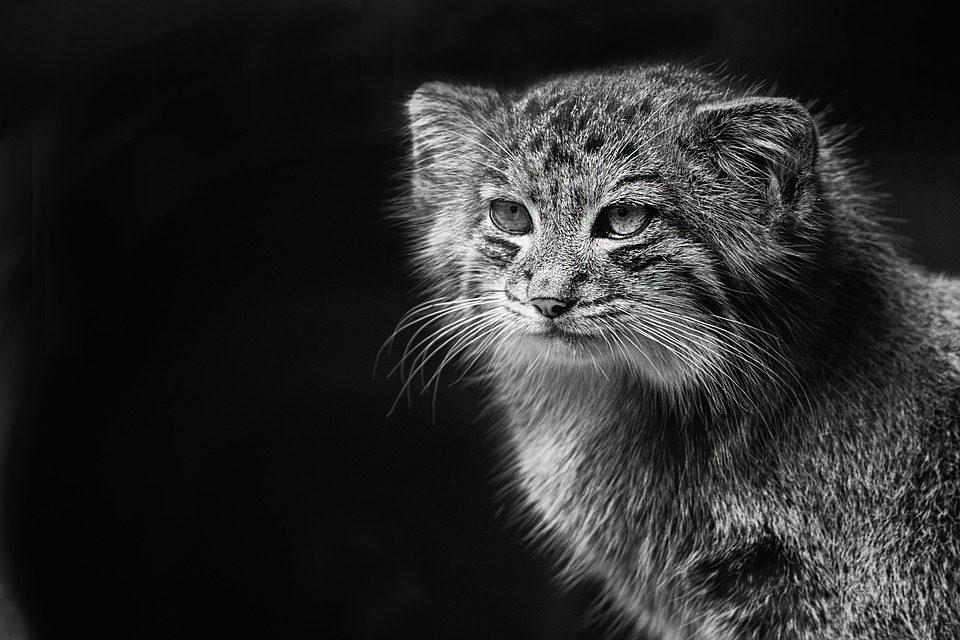
Pallas’s Cat also called manul, is distinguished from other cats by its greyish face, stout build, and long hair with white tips giving it a frosted appearance. Unlike other cats, their pupils don’t contract in vertical slits, rather it becomes small dark circles. It has the densest and longest fur among the other cat which helps to insulate them against cold. They wrap their well-furred tail around the body like a warm muff.
They prefer rocky areas, crevices, caves, and mountain steppes even sheltering in abandoned dens of marmots and foxes. They are solitary cats and scent mark their territories of 2 to 4 km. They ambush and stalk their prey before they seize it. Pika being their favorite prey, comprises around fifty percent of their diet.
Best place to spot Pallas’s cat in India – Rarely sighted in Ladakh and trans-Himalayan region of Sikkim. Most of the records are obtained using camera traps currently.
4. Asiatic Wild Cat (Felis sylvestris)
IUCN status- Least concern

Asiatic wild cats are mistaken with domestic cats for having similar features. It is also said to be the closest wild ancestor of domestic cats. Inter-breeding happens in areas where both dwell in. Their primary habitat is desert where they live in burrows.
Their diet constitutes of gerbils, hares, partridges, peacocks, sandgrouse, eggs of land birds, and even snakes, geckos, and beetles.
Their furry feet help them to walk through rocky and hot landscapes. They are prolific diggers, as it is important to construct and maintain their burrows in the sand and also to dig rodents out of it. Thus their claws do not completely retract, unlike big cats.
Best place to spot the Asiatic wild cat in India – Desert national park, Rajasthan and arid regions of Gujarat and Madhya Pradesh
5. Eurasian Lynx (Lynx lynx)
IUCN status- Least Concern
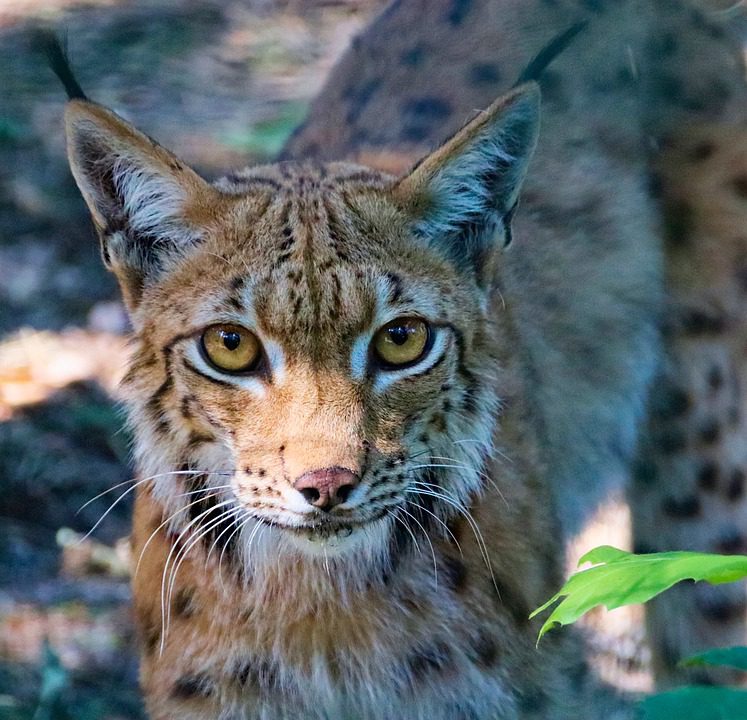
Out of the four lynx species, Eurasian lynx is the largest on planet earth. Having a habitat ranging across Europe, Russia, Central Asia and India holds its southern edge. They are found in limited areas in Ladakh, POK, Sikkim and North-Eastern parts of our country.
They spend most of their day time resting in crevices, mountain steppe, woodland areas, thickets, etc. They mostly feed on hares, and small ungulates like goats and boars.
They differ from other medium-sized cats by its long black ear tufts, a very short tail (which only reaches its hough), and distinctive sandy pale grey coat on the body. It is more active during dusk and dawn. Lynx bury any uneaten prey and return the next day to finish it
Best place to spot Eurasian Lynx in India – Ladakh, Himachal Pradesh, and Sikkim. Sightings are rare and most records are obtained using camera traps.
6. Asian Golden Cat (Catopuma temminckii)
IUCN status- Vulnerable
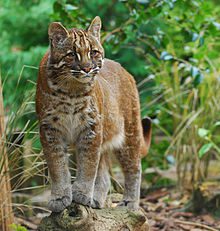
Asian Golden Cat is very similar to the North American Puma with the remarkable size difference and black stripes on the face. It is also known as ‘Fire Cat’ due to the presence of spots and stripes on their body. This, sometimes, leads them to be misidentified for a young leopard.
During a study held in Arunachal Pradesh on Golden cats, it was found (in camera traps) that their coat may vary in colors like cinnamon, golden, gray, and melanistic. Even though they weigh 8 to 15 kg, they are capable of hunting down large prey like sheep and goats.
Needless to say, being very secretive, it is a nocturnal forest dweller. These cats are purely carnivorous and opportunistic feeders. Golden cats are found in rocky areas as well as in forests, scrubs and grasslands.
Best place to spot Asian Golden cat in India – Manas national park, Assam
7. Caracal (Caracal caracal)
IUCN status- Least concern

A mysterious cat from the arid regions of Rajasthan, Gujarat, and Madhya Pradesh, Caracal is now on the verge of extinction. Its name ‘Caracal’ is derived from the Turkish word ‘karakulak’ which means ‘black ear.‘ Easily distinguished by its long, black tufted ears similar to the Eurasian lynx, caracal is generally swift, nocturnal, and solitary.
It preys predominantly on hares and rodents and can easily jump up to 3 meters (with the help of their powerful hind legs) to catch birds in the air.
Caracals breed throughout the year and normally a litter of 1 to 6 kittens are born. Their gestation period is around 2 to 3 months. The kittens stay with the mother for around 8 to 9 months before they leave her and make their own range.
Best place to spot Caracal in India – Central India and Ranthambore National Park but sighting them is rare. Most records are obtained from using camera traps
SMALL CATS OF INDIA

1. Leopard Cat (Prionailurus bengalensis)
IUCN status- Least concern

The tiny version of an Indian leopard, these nocturnal and crepuscular (active during twilight) cats favored habitat is, tropical evergreen rain forest, cultivated area, moist deciduous forest, and grasslands. It is solitary, but can be seen in a pair during mating or with dependent young ones.
Two prominent white streaks are present between the eyes and their muzzle is also white. They lack rosettes, but have black spots throughout their coat. Its tail is half the size of its body and they weigh around 3 to 4 kgs only.
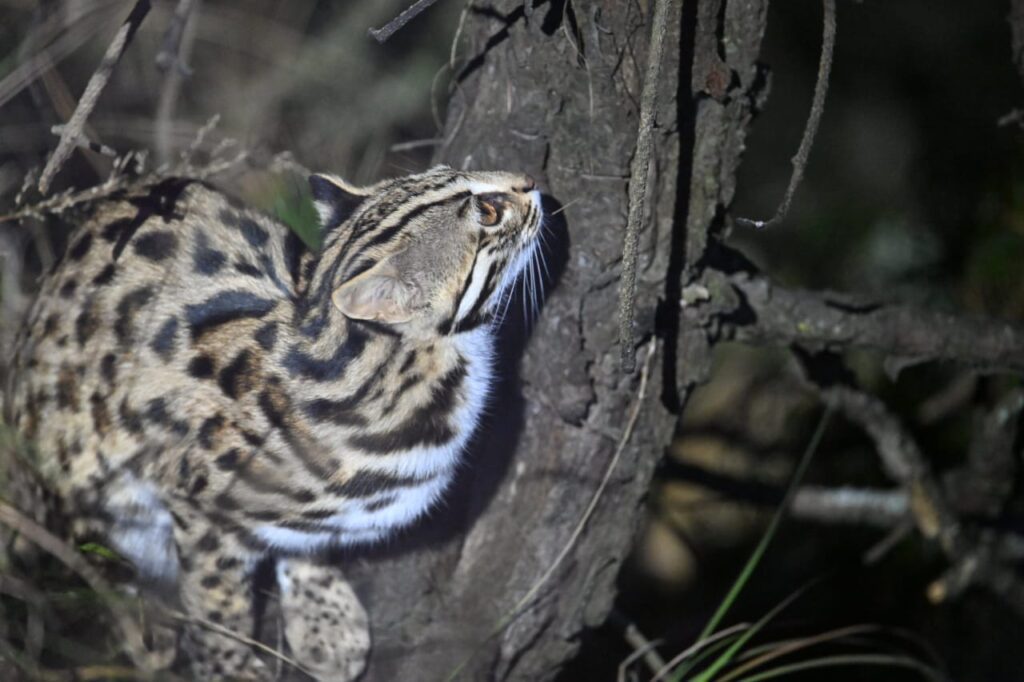
They feed on hares, tree shrews, lizards, and amphibians and are excellent climbers. Due to their arboreal nature, they easily conceal themselves in dense forest cover and vegetation.
Their breeding season varies depending on climatic conditions and after a gestation period of 60 – 70 days, 2 to 3 kittens are born. They stay less than a year before they separate from their mother. Sexual maturity is reached by 13 to 14 months.
Best place to spot Leopard cat in India – Biligiri Rangaswamy Temple (BRT) Tiger Reserve, Bhadra Tiger Reserve, and North-East India
2. Marbled Cat (Pardofelis marmorata)
IUCN status- Near Threatened
Marbled cat is considered as the miniature version of clouded leopard with thick, dark blotches on the upper body and black spots along its tail and legs. It has a short and more rounded head compared to other feline members with a wider forehead and larger pupils. It is found in North East India and other South-East Asian countries.
Marbled cat is similar in size to the domestic cat with more slender and elongated body. It weigh 2 to 5 kg only and lead a solitary life. It is an agile climber and arboreal by nature due to which, it is also known as ‘Old World Margay’. Its diet consists of birds, rodents, smaller mammals and reptiles.
In captivity its been found that their gestation period varies from 65 to 80 days and 1 to 4 kittens are born in a litter. It achieves sexual maturity within two years.
Best place to spot Marbled cat in India – Namdhapa National park, Pakke Tiger reserve in Arunachal Pradesh
3. Rusty Spotted Cat (Prionailurus rubiginosus)
IUCN status- Near Threatened

The world’s smallest cat, the hummingbird of the cat family, Rusty-spotted cat is found in India, Nepal and Srilanka. A fully grown adult is similar in size to a domestic kitten. It weighs only 1.5 to 1.6 kg making it the lightest cat in the world. It is extremely shy, prefers rocky areas, scrub, dry and open forests and also inhabit near human settlements.
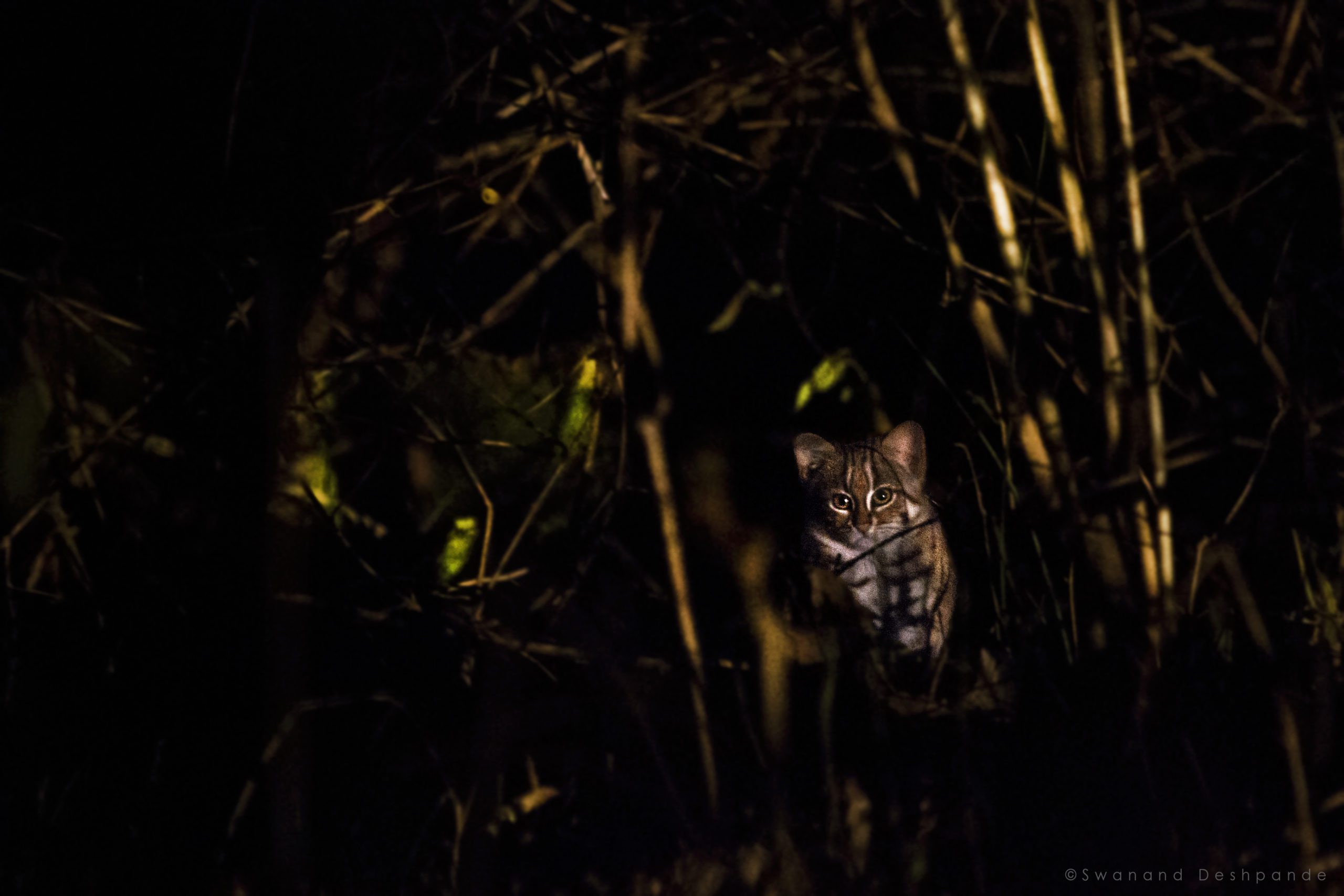
The best identification key for rusty-spotted cat is its unmarked tail and whitish lip, chin and undersides. Its eyes are also ringed white. It is a nocturnal species, having arboreal tendency. The main tool for communication in these cats is scent. Both male and female spray urine for scent marking.
They normally feed on reptiles, frogs, rodents, insects and small birds. Major threat to these little precious cats are habitat destruction and deforestation in India.
Best place to spot Rusty spotted cat in India – Satpura, Bandhavgarh, Panna, Gir and Mundanthurai National parks.

Did you know?
Dehing Patkai Wildlife Sanctuary situated in Assam, India, is the only place in the world where 7 species of wild cats thrive in its rain forest.
Written By : Mugdha Desai and Swanand Deshpande, Naturalists at Denwa Backwater Escape, Satpura and Ashish Tirkey, Manager, Tree House Hideaway, Bandhavgarh
Edited by: Natasha Sinha, Content Curator, Pugdundee Safaris.
Visit our lodges in Kanha, Bandhavgarh, Pench, Satpura, and Panna to watch various fascinating species of the forests frolic in the untamed wild. Get in touch with our trip curators at Pugdundee Safaris to book your next wildlife holiday.
Our trip curators at Pugdundee Safaris are more than happy to assist you. Phone: +91-011-40132680 Email: [email protected]

